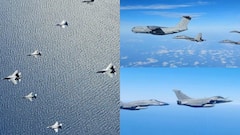Opinion: How Indian Navy Anchors Stability Across The Indian Ocean Region And West Asia
Through cooperative alliances, humanitarian engagement, and a measured counterbalance to China’s influence, India’s maritime outreach is cultivating an environment where shared security thrives.

India is emerging as a stabilising force across the Indian Ocean Region (IOR) and West Asia in an era of escalating geopolitical competition and shifting power dynamics. The Indian Navy, once focused on coastal defence, now plays a pivotal role in shaping regional security and cooperation, serving as a linchpin of India’s foreign policy. Guided by Security and Growth for All in the Region (SAGAR) initiatives, India’s maritime strategy is balanced, and prioritises fostering partnerships while safeguarding its strategic interests.
Through a blend of cooperative alliances, humanitarian engagement, and a measured counterbalance to China’s influence, India’s maritime outreach is cultivating an environment where shared security thrives, enabling India to emerge as a trusted and proactive regional power. It is pertinent to explore the evolving dimensions of India’s maritime strategy, from enhancing the naval capacities of neighbouring states to deepening strategic ties in West Asia. Each initiative reflects a nuanced approach, advancing India’s commitment to regional stability while promoting multipolarity in an increasingly contested maritime domain.
ALSO READ | Indian Navy At RIMPAC 2024 Wargame: Credible, Cohesive, Combat-Ready
A Strategic Pillar In The Indian Ocean
Efforts to bolster regional security and maritime resilience highlight India’s strategic approach within the IOR. A recent example is the delivery of Fast Interceptor Craft (FICs) to Mozambique on November 8, 2024, strengthening Mozambique’s ability to combat maritime terrorism, piracy, and insurgency — particularly in the volatile Cabo Delgado region. These water-jet-propelled vessels enhance Mozambique’s response capabilities and reflect India’s longstanding commitment to regional security, following previous naval support that included two large interceptors in 2019 and additional FICs in 2022.
Moving north, India’s engagement with Sri Lanka emphasises collective security and interoperability. The port call of INS Vela in Colombo exemplifies the deepening cooperation under SAGAR’s principles, prioritising mutual security over unilateral dominance. Joint exercises, information sharing, and personnel exchanges foster operational coordination, enhancing both nations’ readiness against piracy, trafficking, and other non-traditional security threats. India's capacity-building initiatives are not simply about tactical advantage; they strengthen bonds of trust, helping regional allies counterbalance China’s strategic investments across the IOR, such as the Hambantota Port in Sri Lanka.
India’s approach, rooted in mutual respect and long-term support, contrasts sharply with China’s infrastructure-led engagements, often resulting in debt dependencies. Through equipment provision, training, and logistical support, India offers a comprehensive security partnership that empowers local maritime forces without compromising their autonomy.
Balancing China’s Influence: A Delicate Diplomatic Deterrent
China’s assertive posture in the IOR, characterised by expanding port networks and an increasing naval footprint, has raised regional concerns about the potential for hegemonic dominance. India’s approach to countering this influence is subtle yet effective: it fortifies the capabilities of its neighbours, enabling them to secure their waters independently and maintain a balance of power. India encourages a cooperative rather than coercive security framework by fostering self-reliance in maritime security among IOR states.
India’s maritime diplomacy, often seen in joint exercises and shared security responsibilities, represents a “soft-power” alternative that resonates with regional stakeholders. In contrast to China’s infrastructure-heavy model, India’s support — encompassing anti-piracy operations and Exclusive Economic Zone (EEZ) monitoring — offers an appealing alternative, allowing nations to strengthen their security frameworks without the financial strains associated with high-debt financing.
ALSO READ | 25 Years Of Kargil: Why India Needed An Agnipath-Like Scheme
Extending Influence In West Asia
India’s naval engagements extend beyond the IOR, reflecting the strategic importance of West Asia for India’s energy security and economic interests. In recent years, India has intensified its maritime presence through high-profile port calls and joint exercises with Gulf Cooperation Council (GCC) nations as well as Iran, signalling its intention to be a responsible security partner in a region long considered within Pakistan's sphere of influence.
In 2024 alone, India’s First Training Squadron (1TS), led by INS Tir, INS Shardul, and ICGS Veera, conducted operations across the Gulf, with deployments in the United Arab Emirates, Oman, Bahrain, and Iran. These missions included tactical drills and exchanges addressing shared security issues such as smuggling, piracy, and terrorism. Each visit reinforced India’s commitment to a stable maritime environment that supports secure trade routes — a vital factor given that around 60% of India's oil imports originate from West Asia.
In the UAE, India’s Chief of Naval Staff, Admiral Dinesh K. Tripathi, supervised the third India-UAE Bilateral Naval Exercise, deepening strategic alignment and building trust through joint tactical coordination. Oman, too, remains a longstanding partner, demonstrated by the recent Naseem-Al-Bahr exercise featuring complex drills that reinforce mutual readiness in the Arabian Sea. Even with Iran, India has maintained a careful balance, conducting joint exercises in Bandar Abbas that underline India’s nuanced diplomacy — a tightrope act between Gulf nations and Iran, each of which holds strategic importance for India.
Economic Imperatives Underpinning Maritime Security
India’s maritime strategy is not merely about defence but is intrinsically linked to its economic interests. The Persian Gulf and the Arabian Sea, through which substantial energy supplies transit, are critical to India’s economy, with the UAE alone accounting for a large portion of India’s oil imports. India’s naval presence in these waters aims to protect energy corridors, contributing to the security of regional partners as well.
The 2022 Comprehensive Economic Partnership Agreement (CEPA) with the UAE, which catalysed a 38% surge in bilateral trade, further emphasises the economic stakes driving India’s maritime engagement. Positioning itself as a reliable security partner, India helps safeguard trade and energy routes, fostering an environment where economic prosperity can flourish with maritime security.
Humanitarian Outreach And Soft Power
India’s outreach extends beyond strategic exercises and trade; it involves a commitment to humanitarian engagement and bolsters its image as a compassionate and reliable ally. For instance, following the 2023 earthquake, India’s aid to Turkey and Syria amplified its regional humanitarian profile. The Indian Navy has conducted community engagement activities, cultural exchanges, and charity events across West Asia, fostering goodwill and reinforcing India’s standing as an empathetic partner.
India’s cultural exports, such as Bollywood, and shared historical ties, augment its soft power, reinforcing its image as a culturally attuned and approachable regional power. This humanitarian engagement complements India’s security goals, strengthening its reputation as a stabilising presence that champions regional security and sociocultural connections.
Supporting A Multipolar West Asia
India’s expanding maritime presence reflects its support for a balanced, multipolar order in West Asia. As the region increasingly engages with diverse global players — including the United States, China, and India — New Delhi’s stance encourages West Asian states to diversify partnerships rather than rely on any single power. Through SAGAR, India advocates for an inclusive maritime framework where regional actors, including Pakistan, can share in a stable maritime order.
India’s contribution to collective maritime security — through anti-piracy efforts, open trade routes, and maritime law enforcement — benefits the IOR and Gulf states and regional stability. This non-threatening approach strengthens India’s appeal as a dependable partner in West Asia, fostering an environment where cooperation supersedes rivalry.
India’s Resilient Maritime Strategy For A Dynamic Region
India’s maritime strategy encapsulates a multidimensional approach to regional stability. Through strategic alliances, humanitarian outreach, and cooperative security initiatives, India’s Navy has transformed into an anchor of stability from the IOR to West Asia. Guided by the SAGAR framework, India has crafted a nuanced approach that blends hard power with soft power, aligning with the diverse aspirations of regional and global partners.
As the IOR and West Asia navigate evolving dynamics, India’s role as a stabilising force — driven by a commitment to regional peace and growth — will be instrumental in shaping a secure, prosperous maritime future. In crafting a balanced and cooperative order, India’s Navy anchors stability and charts a forward-looking course for a resilient, interconnected region.
Aritra Banerjee is a defence and security analyst.
[Disclaimer: The opinions, beliefs, and views expressed by the various authors and forum participants on this website are personal and do not reflect the opinions, beliefs, and views of ABP Network Pvt. Ltd.]





































